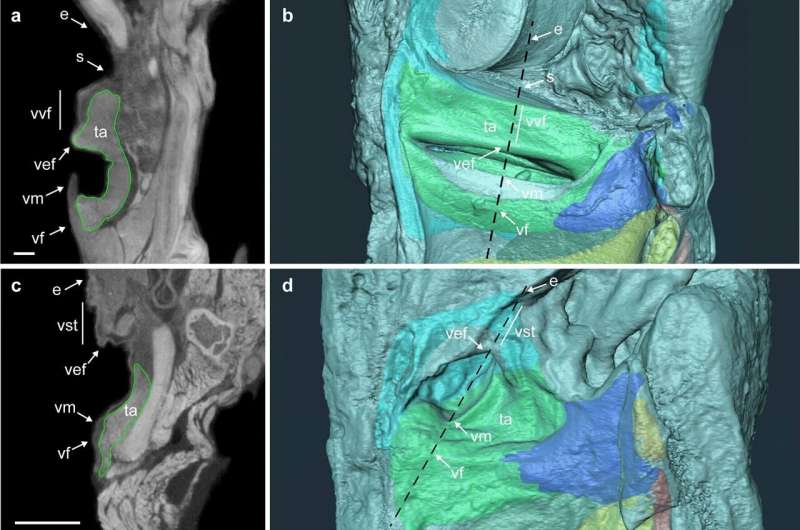This article has been reviewed according to Science X's editorial process and policies. Editors have highlighted the following attributes while ensuring the content's credibility:
fact-checked
peer-reviewed publication
trusted source
proofread
Study is first to describe and recreate lemurs' one-of-a-kind vocal structure

New research has discovered that lemurs, the small primates native to Madagascar, are capable of exaggerating their size thanks to the unique structure of their larynx.
Published in the journal Scientific Reports, the study is the first to show that different species of lemurs all possess an anatomical feature unlike any other primate—an additional pair of vocal folds. The researchers were also able to demonstrate the function of this one-of-a-kind structure.
Co-authored by Dr. Jacob Dunn of Anglia Ruskin University, and led by colleagues from Kyoto University in Japan, the study involved carrying out CT scans of the larynges of different species of lemurs and then constructing a silicone model to recreate and test the acoustic properties of these additional vocal folds.
The researchers studied the larynges from two families of lemurs—Lemuridae, which include the ring-tailed lemur (Lemur catta) and black-and-white ruffed lemur (Varecia variegata), and Cheirogaleidae lemurs, such as the gray mouse lemur (Microcebus murinus)—and found that both families possess these unique vestibular vocal folds.
The results suggest that lemurs acquired the twin vocal folds as a novel evolutionary adaptation, and this feature was probably acquired by their common ancestor at least 35 million years ago.
Non-human primates possess a range of different call types and produce these using the same basic principles as speech production in humans. The initial noise is generated by airflow from the lungs, which causes vibrations in the larynx. The amplitude (loudness) and frequency (pitch) of the call is determined by the specific acoustic properties of the larynx and vocal tract.
In a similar way that howler monkeys' enlarged larynx, into which a laryngeal air sac extends, allows them to be such powerful long-distance communicators, the researchers believe lemurs' additional vocal folds have similar practical benefits.
They suggest they are responsible for enriching the lemurs' vocal repertoire, allowing them to make a wider variety of calls, and also making vocalization more efficient, meaning they expend less energy communicating over distances.
By creating and testing a silicon model of the larynx, the researchers found that the additional vocal folds also lower the frequency of the sounds produced. This makes a lemur sound larger than it actually is, and being able to exaggerate its size may have important benefits, particularly around competition.
Co-author Dr. Jacob Dunn, Associate Professor in Evolutionary Biology at Anglia Ruskin University (ARU), said, "All primates have a pair of vocal folds in their larynx, which vibrate to modify the air flow, and our research shows that all species of Madagascan lemurs have a unique additional pair of folds in the vestibular region, parallel to the vocal folds.
"This is likely to have developed because ancestors possessing these twin vocal folds may have had a selective advantage compared with members of the same species without this adaptation.
"We think these twin vocal folds serve to not only increase the complexity of their calls but crucially may also help a lemur exaggerate its body size, which would have significant benefits when competing for territory or mates."
Senior author Professor Takeshi Nishimura, of the Center for the Evolutionary Origins of Human Behavior at Kyoto University, said, "Primates use varied vocal repertoires to communicate, and the larynx plays a key role in generating these calls.
"By recreating the lemurs' unique vocal structure through our model and studying its oscillation properties, we found that simultaneous vibrations of the twin pairs of vocal folds lowers the frequency of the calls produced—helping the lemur sound larger than it is—and also serves to improve vocal efficiency."
More information: Kanta Nakamura et al, Twin vocal folds as a novel evolutionary adaptation for vocal communications in lemurs, Scientific Reports (2024). DOI: 10.1038/s41598-024-54172-z
Journal information: Scientific Reports
Provided by Anglia Ruskin University




















